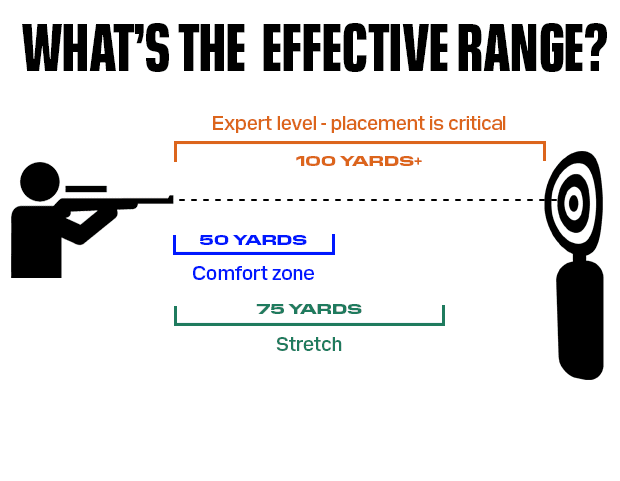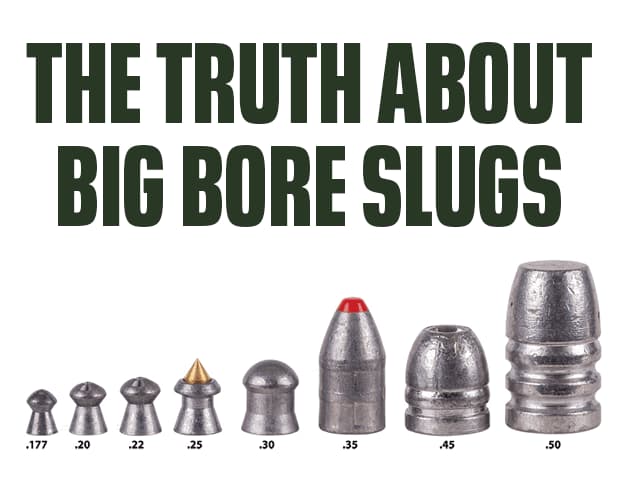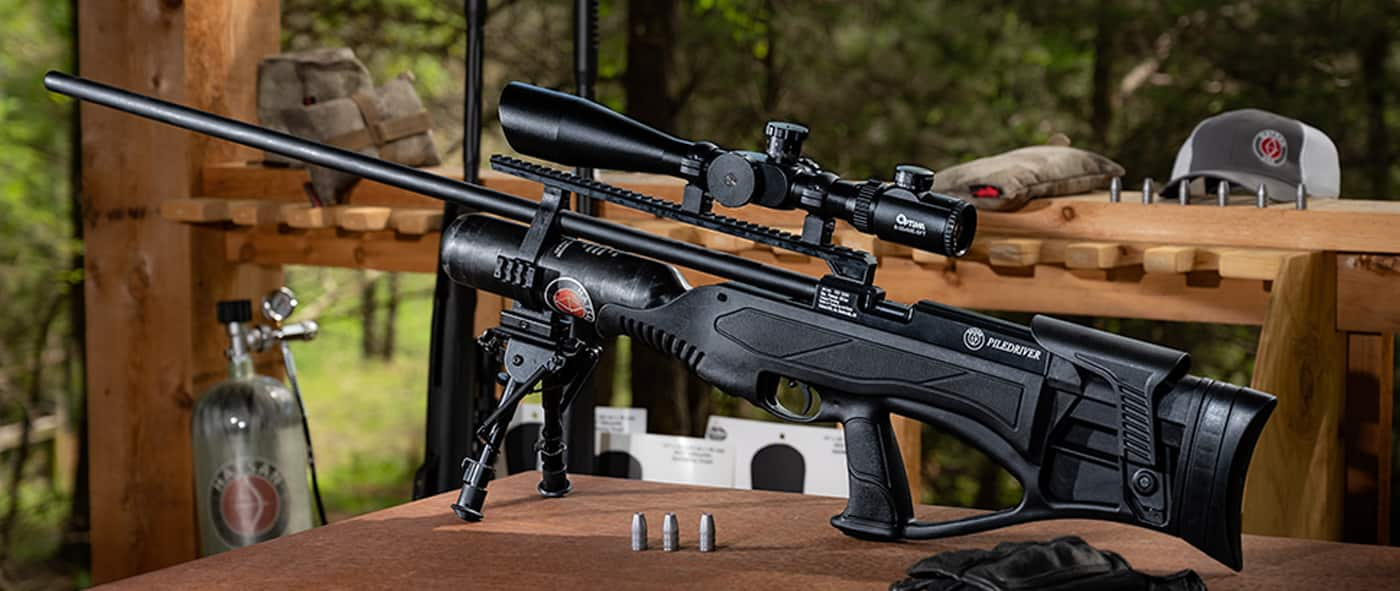When the temperatures begin to cool and the leaves start to change, hunting seasons open, and that gets airgunners thinking about hunting. If you aim to go after large game, you'll need a large caliber rifle (.357 caliber or larger) to get the job done right. Here are some big bore hunting tips to help you out.
Pick a Rifle with Enough Power
Every air rifle has its pros and cons, as well as its performance qualities. To match your rifle and ammunition to the quarry, We recommend you calculate a minimum of 2 foot-pounds of energy (fpe) for each pound in weight of the quarry. (This applies to pellet and slug firing big bore air rifles, not arrow or bolt-firing air rifles. Arrows with broadheads require a different energy calculation than pellets.)
For example, a 150lb deer will require 300 fpe for a clean kill. So you would choose an air rifle that produces 300 fpe or more for that quarry. You can measure the foot-pounds of energy your gun and ammunition produce by calculating the velocity with the weight of the pellet.
- A .357 that shoots pellets at 900 fps will put out a 100-grain pellet at 180 fpe.
- A .45 that shoots pellets at 850 fps will put out a 200-grain pellet at 320 fpe.
- A .50 that shoots pellets at 1100 fps will put out a 320-grain pellet at 860 fpe.
Any big game hunting air rifle needs to be a big bore, ideally .35 caliber or larger, but bigger tends to be better. To achieve the necessary power in these calibers, you'll need to look exclusively at a pre-charged pneumatic or pcp air rifle. The other powerplants just don't have the power necessary to take out big game. When you're shopping for a big bore, consider the game you are hunting, the caliber you want to hunt with, and the ammo you are going to use.
Along with game size, caliber, and power, you also need to consider your effective range.
Get Up Close and Personal
Your effective range is the distance from which your air gun can kill your quarry cleanly and efficiently. Think one-shot kill.
Though many high-powered big bore air rifles can put a pellet on paper beyond 100 yards, we recommend taking your prey at between 35 and 50 yards. Air rifles shoot projectiles at sub-sonic velocities, which can give your prey time to react to the sound of the rifle firing. Closing the distance reduces the likelihood that the game can react and potentially turn a well-placed shot into one that misses the mark. The farther your slug has to travel to hits its mark, the farther off-target it can get. This can lead to missing the animal altogether, or worse, wounding an animal that's unrecoverable.
A wounded animal can still travel long distances. If you lose sight of it, and the blood trail stops, you may never see that deer again. If you are unable to track your game, the chances of recovering that animal are reduced to nearly zero.
Closing the distance is the beginning to clean kills and quick recoveries.
Placement Matters
Target practice may not seem exciting, but reliably hitting the air gun target is very important. Each animal has a kill zone. For some it's the head, for others it's the "Vital V," the area of the vital organs (heart/lungs). Hitting the kill zone ensures the most effective shot for a clean kill.
You should practice your marksmanship from every position you may find yourself in the field (standing, kneeling, sitting, prone) so that you are confident you can make the shot every time you pull the trigger.
Spend as much time at the range as you need to perfect your shooting skills. Even if it takes you 100 hours to hit the bullseye consistently, it'll be worth it to have confidence in your shot.
Using Optics in the Field
There are lots of options when it comes to optics. And different optics do different things. You have binoculars for glassing, rangefinders, spotting scopes, and mounted scopes. It may be overwhelming to decide what you need for your hunt and setup.
Spotting prey is difficult without enhanced vision. You'll see things with binoculars that you'll never see with the naked eye. And though, not everyone uses binoculars, they can be very handy, especially if you're using a spotter on your hunt. The spotter can keep an eye on your quarry while you're on the move and let you know how close you are to it when you stop. The spotter can also keep an eye on your quarry after you take the shot to make it easier for you to track down and recover.
While you can use the scope mounted to your rifle to spot game, it's not recommended. It gives too limited a field of view, even when you change your aperture settings. A spotting scope or binoculars are a much better way to spot prey.
A rangefinder could be one of your best tools on the hunt, especially when you want to keep your distances close. It can be difficult to tell how far your quarry is on the fly, so scoping out distances to landmarks will help you know if your target is in your effective range.
Stay Calm Under Pressure
The pressure can be intense when you're in the blind or crouched behind a bush fixed on your target that's mere yards away, trying to discern whether it will keep eating or run away. As the adrenaline begins to flow through your system, you might experience what many hunters refer to as "Buck Fever." Often losing some of your awareness and potentially leading to mistakes that can ruin your opportunity. That is the very moment you need to take a breath, calm your mind, and rethink your shot.
Too many people get caught up in the moment and take the shot just for it to go awry. Even experienced hunters can get caught up in the moment, and take a bad shot. But if you pause to breathe, calm your mind, look at your angle and trajectory, keep your focus, and anticipate the movement of your quarry, you'll be more apt to hit the target cleanly and have a good recovery.

Big Bore Range
What's the effective range of a big bore air rifle?Big game animals have been harvested with air guns at distances greater than 100 yards, but the effective range we recommend is 75 yards or closer. Staying within 75 yards will give you the best chance of successfully dispatching your game quickly and ethically.
Practicing with your air gun at 50-100 yards is critical to learning what your gun does at various ranges. Knowing your trajectory out to 100 yards with the projectile you plan to hunt with will prepare you for the hunt and help you build confidence to make a clean shot.

The Truth About Big Bore Ammo
Because they travel below the speed of sound and don't typically produce hydrostatic shock, big bores rely more on accuracy than energy to take down game. That's not to say energy isn't important, it absolutely is. But getting the right shot placement on your target is going to be vital, whether you're hunting with a 250 FPE .45 cal, or one producing upwards of 700 FPE.
Additional Hunting Resources
For more tips and information, check out these other pages in our hunting guide:






